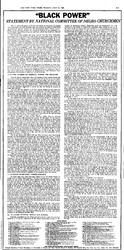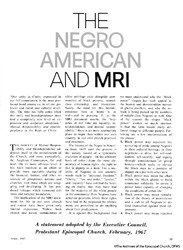Black Power
Emergence
Striving to express a new racial consciousness among blacks in the United States, the emerging Black Power movement eventually overshadowed the conciliatory and integrationist model of ESCRU. A new militancy that mirrored national events of the late 1960s gained strength among African Americans within the Church.
Resignation
In 1966 and 1967, tension between two factions of ESCRU, one headed by Executive Director John Morris, which sought continued work on full integration and elimination of racism in the Episcopal Church, and the other headed by Board President Malcolm Peabody, which favored a shift in emphasis to confronting northern racism and the wider urban crisis, came to a head. When the majority of ESCRU members endorsed the direction supported by Peabody, Morris resigned as Executive Director. [Sources]

Position statement formulated in support of Black Power by the National Committee of Negro Churchmen, signed by nine Episcopalians including Suffragan Bishop Burgess of Massachusetts, 1966.



